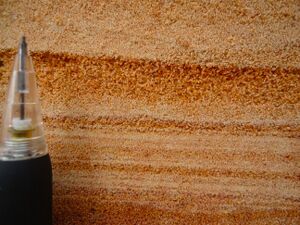Botucatu Formation
The Botucatu Formation is an aeolian sandstone deposit, which displays large-scale sets of cross strata (1 - 30 m)(Figure 1.), formed in a desert environment similar to today’s Sahara Desert, during the Jurassic to Cretaceous on the Gondwanna Supercontinent, with an area of c.1,500,000 km2 (Milani et al., 2007)[1] .
It´s thickness can reach 400 m, the base is made of conglomerates and gravelly sandstones and coarse-grained sandstones, representing ephemeral streams and aeolian sand sheet deposits. It consists mainly of fine to medium-grained quartz sandstones, of red, pink or pale yellow color, well sorted, texturally mature, may contain altered feldspar cemented by silica or iron oxide, which gives it the reddish colour and also shows inverse grading (Scherer & Goldberg, 2007)[2].(Figure 2.)
It´s morphologic reconstruction shows simple to compound aeolian dunes and complex linear draas. It´s preservation is due to the fragmentation of the Gondwana Supercontinent when lava flows from the Serra Geral Formation covered this erg (Scherer et al., 2000)[3].
The paleowind regimes show a monsoonal pattern during the Jurassic and Cretaceous, the main winds blew to the NE during the Southern Hemisphere winter and to the SE during the Southern Hemisphere summer (Scherer & Goldberg, 2007)[2].
One of the largest aquifer system, the Guarani Aquifer, is located in the Paraná Basin and the Botucatu Formation is part of it as a very permeable sandstone sealed by the lava flows from the Serra Geral Formation (Scherer 2002)[4].
References
- ↑ Milani, E.J.; Melo, J.H.G., Souza, P.A.; Fernandes, L.A.; França, A.B. Bacia do Paraná. In: Cartas Estratigráficas - Boletim de Geociências da Petrobras, Rio de Janeiro, v.15, n.2, p.265-287, mai/Nov. 2007
- ↑ 2.0 2.1 Scherer, C.M.S., Goldberg, K., 2007. Palaeowind patterns during the latest Jurassic–earliest Crateceous in Gondwana: Evidence from aeolian cross-strata of the Botucatu Formation, Brazil. Elsevier, Science Direct, Palaeogeography, Palaeoclimatology, Palaeoecology 250 (2007) 89-100.
- ↑ Scherer, C.M.S., Faccini, U.F., Lavina, E.L., 2000. Arcaboucoestratigráfico do Mesozóico da Bacia do Paraná. In: Holz, M.,C.M.S. Scherer, K. Goldberg / Palaeogeography, Palaeoclimatology, Palaeoecology 250 (2007) 89–100 99De Ros, L.F. (Eds.), Geologia do Rio Grande do Sul. Editora daUniversidade/UFRGS, Porto Alegre, pp. 335–354.
- ↑ Scherer, C.M.S., 2002. Preservation of aeolian genetic units by lava flow in the Lower Cretaceous of the Paraná Basin, southern Brazil. Sedimentology 49, 97–116.

